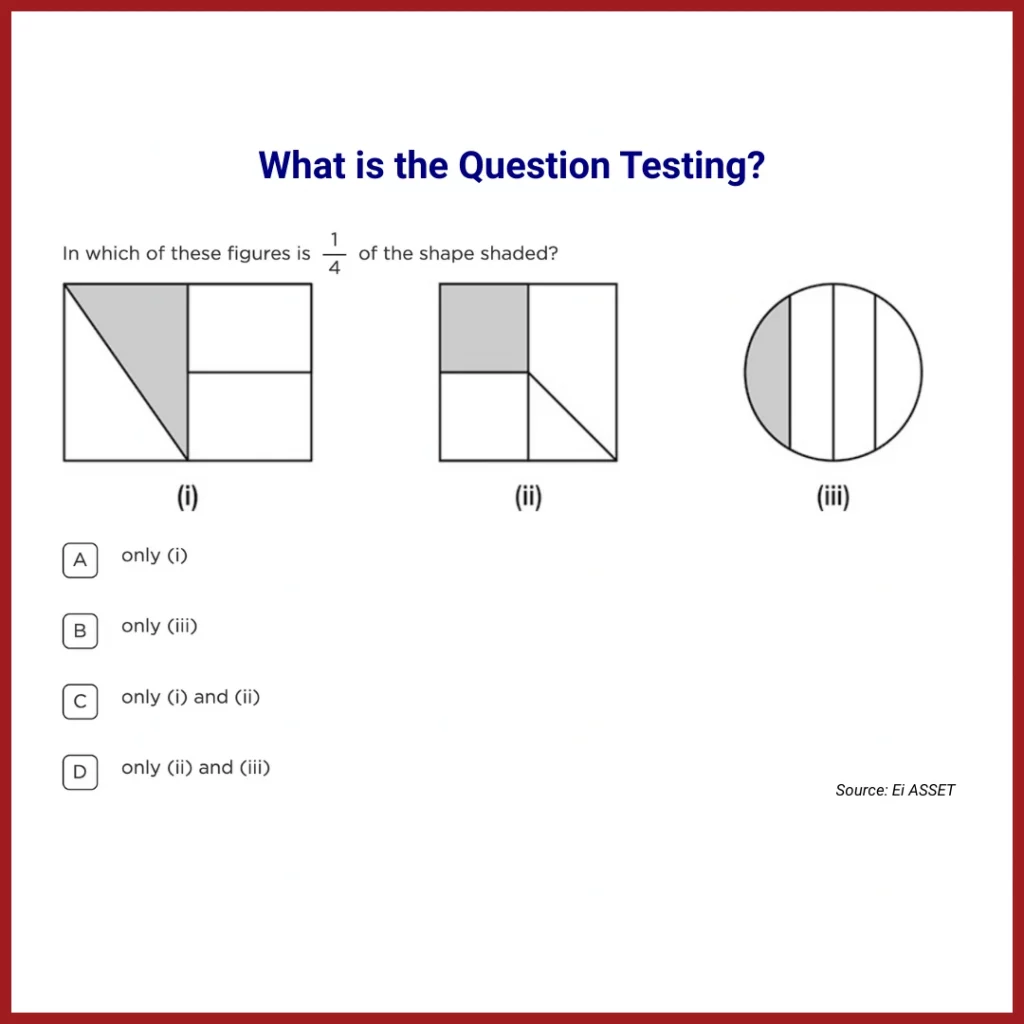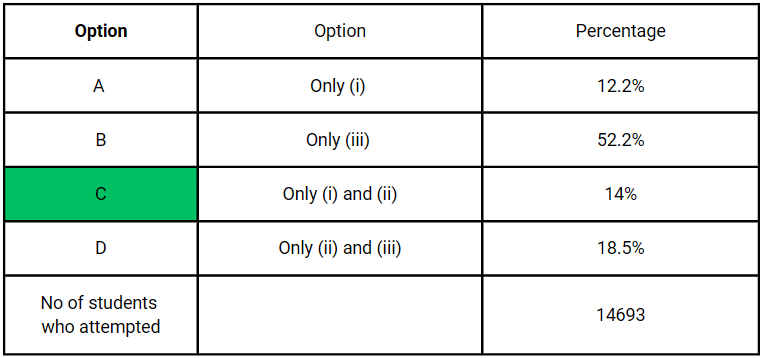Learning
Pulse
Edition 03 | March 2025
From Learning Data to Classroom Instruction
Class 5- Mathematics

National Performance

What is the Question Testing?
This question tests students’ understanding of fractions as equal parts of a whole and the concept that “half of half” equals one-fourth. Students need to recognise that figures (i) and (ii) each have 1/4 of their areas shaded because “half of half” of the shape is shaded. However, figure (iii) does not represent 1/4, as it is divided into unequal parts, and the shaded area is not one-fourth of the whole.
What is the Most Common Wrong Answer and Possible Misconception?
Distractor Explanation:
- Option B:
Students choosing Option B may have dismissed figures (i) and (ii), assuming they are not valid representations of 1/4 because the shaded areas are triangular or asymmetrical. However, these students fail to notice that figure (iii), the circle, is also divided into unequal parts. This suggests that they may not have understood the importance of equal divisions in defining fractions.
- Option A (12.2%):
Students selecting this option correctly identified that 1/4 is shaded in figure (i). However, they may have dismissed figure (ii) due to unfamiliarity with its rectangular division and ignored figure (iii) entirely. This indicates an incomplete understanding of fractions in diverse representations.
- Option D (18.5%):
Students selecting this option likely identified figure (ii) as correct but assumed figure (iii) was also valid. They may not have recognised that figure (iii) is divided into unequal parts, showing a limited understanding of how fractions relate to equal partitions. Additionally, these students may have missed the triangular shading in figure (i), demonstrating difficulty generalising the concept of fractions.
What Will Happen if Children Do Not Show Development of This Concept?
- Impact on Understanding of Fractions: If students do not develop a robust understanding of fractions as equal parts of a whole, they may struggle with equivalent fractions, fraction operations, and applications involving measurements and ratios. Their ability to generalise the concept across diverse shapes and contexts will also remain limited.
- Further Implications: Students may find it challenging to interpret visual representations of fractions in geometry and everyday problem-solving. Misconceptions like these could hinder their progress in understanding proportions, percentages, and other advanced mathematical concepts.
How Should I Remediate This in My Class?
- Hands-On Activity with Paper Folding: Provide students with square sheets of paper to fold into halves, then quarters, in different ways (e.g., horizontally, diagonally, or asymmetrically). Have them shade 1/4 or other fractions to reinforce the idea of equal parts, even when divided differently.
- Explore Fractions Using Diverse Shapes: Use circles, triangles, and irregular polygons to help students see that fractions apply to any whole, regardless of the shape or symmetry of the divisions. For instance, show how 1/4 of a triangle can look different from 1/4 of a rectangle but still represent the same fraction.
- Contextual Practice: Encourage students to draw and shade fractions such as 1/3 of 1/2 or 1/4 of a whole. Ask them to explain their reasoning and compare different representations to deepen their understanding.ct what will happen and then observe the real results during the experiment.
- Contextual Practice: Encourage students to draw and shade fractions such as 1/3 of 1/2 or 1/4 of a whole. Ask them to explain their reasoning and compare different representations to deepen their understanding.ct what will happen and then observe the real results during the experiment.
- Address Misconceptions:
- Highlight why figure (iii) is incorrect due to its unequal parts.
- Clarify how figures (i) and (ii) correctly represent 1/4, even with unfamiliar triangular or rectangular shading.
- Include non-examples and questions in unfamiliar context: By focusing on hands-on activities and diverse examples, students can develop a more flexible and comprehensive understanding of fractions, helping them apply this concept to a range of problems and contexts.
Enjoyed the read? Spread the word
Interested in being featured in our newsletter?
Feature Articles
Join Our Newsletter
Your monthly dose of education insights and innovations delivered to your inbox!
var formDisplay=1;var nfForms=nfForms||[];var form=[];form.id=’5′;form.settings={“objectType”:”Form Setting”,”editActive”:true,”title”:”Subscribe form”,”show_title”:1,”allow_public_link”:0,”embed_form”:””,”clear_complete”:1,”hide_complete”:1,”default_label_pos”:”above”,”wrapper_class”:””,”element_class”:””,”form_title_heading_level”:”3″,”key”:””,”add_submit”:1,”changeEmailErrorMsg”:”Please enter a valid email address!”,”changeDateErrorMsg”:”Please enter a valid date!”,”confirmFieldErrorMsg”:”These fields must match!”,”fieldNumberNumMinError”:”Number Min Error”,”fieldNumberNumMaxError”:”Number Max Error”,”fieldNumberIncrementBy”:”Please increment by “,”formErrorsCorrectErrors”:”Please correct errors before submitting this form.”,”validateRequiredField”:”This is a required field.”,”honeypotHoneypotError”:”Honeypot Error”,”fieldsMarkedRequired”:”Fields marked with an * are required”,”currency”:””,”unique_field_error”:”A form with this value has already been submitted.”,”logged_in”:false,”not_logged_in_msg”:””,”sub_limit_msg”:”The form has reached its submission limit.”,”calculations”:[],”formContentData”:[“your_email_address_1739890914181″,”submit_1739891011065″],”objectDomain”:”display”,”drawerDisabled”:false,”ninjaForms”:”Ninja Forms”,”fieldTextareaRTEInsertLink”:”Insert Link”,”fieldTextareaRTEInsertMedia”:”Insert Media”,”fieldTextareaRTESelectAFile”:”Select a file”,”formHoneypot”:”If you are a human seeing this field, please leave it empty.”,”fileUploadOldCodeFileUploadInProgress”:”File Upload in Progress.”,”fileUploadOldCodeFileUpload”:”FILE UPLOAD”,”currencySymbol”:”$”,”thousands_sep”:”,”,”decimal_point”:”.”,”siteLocale”:”en_US”,”dateFormat”:”m\/d\/Y”,”startOfWeek”:”1″,”of”:”of”,”previousMonth”:”Previous Month”,”nextMonth”:”Next Month”,”months”:[“January”,”February”,”March”,”April”,”May”,”June”,”July”,”August”,”September”,”October”,”November”,”December”],”monthsShort”:[“Jan”,”Feb”,”Mar”,”Apr”,”May”,”Jun”,”Jul”,”Aug”,”Sep”,”Oct”,”Nov”,”Dec”],”weekdays”:[“Sunday”,”Monday”,”Tuesday”,”Wednesday”,”Thursday”,”Friday”,”Saturday”],”weekdaysShort”:[“Sun”,”Mon”,”Tue”,”Wed”,”Thu”,”Fri”,”Sat”],”weekdaysMin”:[“Su”,”Mo”,”Tu”,”We”,”Th”,”Fr”,”Sa”],”recaptchaConsentMissing”:”reCaptcha validation couldn't load.”,”recaptchaMissingCookie”:”reCaptcha v3 validation couldn't load the cookie needed to submit the form.”,”recaptchaConsentEvent”:”Accept reCaptcha cookies before sending the form.”,”currency_symbol”:””,”beforeForm”:””,”beforeFields”:””,”afterFields”:””,”afterForm”:””};form.fields=[{“objectType”:”Field”,”objectDomain”:”fields”,”editActive”:false,”order”:1,”idAttribute”:”id”,”type”:”email”,”label”:””,”key”:”your_email_address_1739890914181″,”label_pos”:”above”,”required”:1,”default”:””,”placeholder”:”Your email address”,”container_class”:””,”element_class”:””,”admin_label”:””,”help_text”:””,”custom_name_attribute”:”email”,”personally_identifiable”:1,”value”:””,”drawerDisabled”:false,”id”:62,”beforeField”:””,”afterField”:””,”parentType”:”email”,”element_templates”:[“email”,”input”],”old_classname”:””,”wrap_template”:”wrap”},{“objectType”:”Field”,”objectDomain”:”fields”,”editActive”:false,”order”:9999,”idAttribute”:”id”,”type”:”submit”,”label”:”Submit”,”processing_label”:”Processing”,”container_class”:””,”element_class”:””,”key”:”submit_1739891011065″,”admin_label”:””,”id”:63,”beforeField”:””,”afterField”:””,”value”:””,”label_pos”:”above”,”parentType”:”textbox”,”element_templates”:[“submit”,”button”,”input”],”old_classname”:””,”wrap_template”:”wrap-no-label”}];nfForms.push(form);
The post From Learning Data to Classroom Instruction appeared first on Ei Study.












